

Draco is a very large constellation which winds itself around Ursa Minor. So, contrary to my usual practice, on the mouseover picture, I have joined the stars of Ursa Minor with dotted lines to emphasise that these are not part of Draco. Also on the mouseover I have indicated the position of the north celestial pole with +, which is about two-thirds of a degree from Polaris in the direction of Kokab.
The Latin word Draco
is conventionally interpreted as Dragon
but in fact the Romans did not have the concept of a dragon as we do today (a fire-breathing monster with four legs and wings as fought by St. George or as depicted on the national flag of Wales). The word means snake
or serpent
; the English word serpent
derives from the Latin word serpere
which means to crawl
. Of course, there is another constellation, Serpens, (the word means a reptile) which is really part of Ophiuchus who is called the Serpent Bearer
but was really a healer and is depicted with a snake entwined around a staff—to this day the symbol of medicine.
The head of Draco is represented by the four stars β, γ, ζ, and ν (Rastaban, Eterin, Grumium, and Kuma). Then the body extends through ο (or 36 and 42 if you prefer) to the five stars τ, ε, ρ, π, and δ which form the first coil, and thence to χ, ψ, ω, and φ, which represent a second coil. The body then stretches out around Ursa Minor and between Ursa Minor and Ursa Major ending either at λ or at HR3751 (depending which atlas you look at).
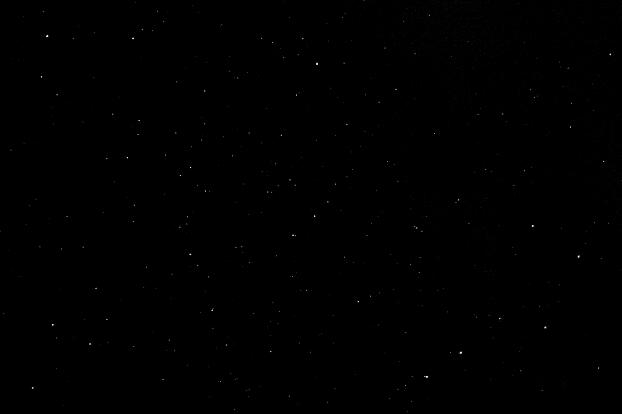 Not a lot is known about Ladon, the monstrous serpent. He was the offspring of Phorkis and his sister Keto, who were the children of a sea god, Nereus, and the Oceanid, Doris, and so were grand-children of Gaia. The Hesperides were a group of singing nymphs in whose garden grew the tree bearing beautiful golden apples that Gaia had put forth as a wedding present to Zeus and Hera. Ladon was given the task of guarding this tree. He was killed by Herakles with a poisoned arrow during his eleventh labour, and transferred to the sky as the constellation Draco.
Not a lot is known about Ladon, the monstrous serpent. He was the offspring of Phorkis and his sister Keto, who were the children of a sea god, Nereus, and the Oceanid, Doris, and so were grand-children of Gaia. The Hesperides were a group of singing nymphs in whose garden grew the tree bearing beautiful golden apples that Gaia had put forth as a wedding present to Zeus and Hera. Ladon was given the task of guarding this tree. He was killed by Herakles with a poisoned arrow during his eleventh labour, and transferred to the sky as the constellation Draco.
Although a large constellation, Draco contains only two stars, β and γ, that are brighter than third magnitude. In dark skies it is not difficult to find, but elsewhere the simplest guide is that β-Draconis is one-third of the way from Vega to Kokab. There are few stars of interest in the constellation. α is one of the closer stars to the Sun at a distance of only 19 light years; it is a dwarf star much less luminous than the Sun. It was the Pole Star 4,000 years ago when the Egyptian pyramids were being built. (In another 12,000 years the Pole Star will be Vega, but it will not be as close to the pole as Polaris is today.) I have named δ Altais
, but this is a secondary name. The usual name is Nodus Secundus
, meaning the second coil
, but this is just too long to fit on my picture. Nodus Primus is another name for Grumium.
The constellation contains two planetary nebulae, the beautiful Cat's Eye Nebula, NGC6543, which is small but bright and its central star of magnitude 9.3 is unusually hot at 35,000 C, and NGC6742 which is a much fainter object at magnitude 13. There are four galaxies in the range of medium-sized telescopes; NGC5866 is probably the object Messier catalogued at M102, and is a lenticular galaxy seen edge on. NGC5907, is a spiral galaxy also seen edge on. Then there are NGC6503, a nice spiral galaxy, and NGC5985, a splendid if faint Seyfert galaxy which has two more faint galaxies within 14 arc-minutes making a nice group for CCD imaging.
The image was made with a Canon 1000D with its own 18-mm lens, an exposure of 10 seconds at f/4 and ISO 1600. It was enhanced by increasing the contrast, brightness, and gamma and a red, background glow removed in PhotoImpact.
All pictures were taken with a DFK 21AF02 camera at prime focus of my LX200. North is at the top. Despite having two Flamsteed numbers, 40- and 41-Draconis are only 19 arc-seconds apart and are a true double star. Together they are Struve 2308. The two stars have very similar proper motions but I do not know if they are associated or mearly in the same line of sight. 41 is a spectroscopic binary.
ι-Draconis is an interesting star. The two stars have different proper motions so are presumably not associated. The primary, called Edasich, is about 100 light-years away and has about the mass of the Sun but 13 times its diameter and 40 times its luminoscity. It is clearly older than the Sun and has entered the later stages of stella evolution with helium burning it its core. Eventually it will throw off some of its mass to form a planetary nebula before finally cooling as a white dwarf. In 2002 a planet was discovered circling the star. It has at least 8.6 times the mass of Jupiter and revolves in a highly eccentric orbit with a period of 511 days.
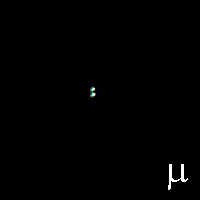 |
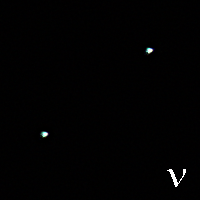 |
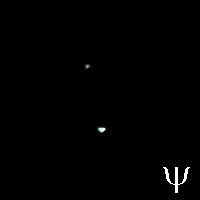 |
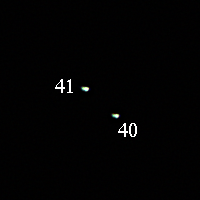 |
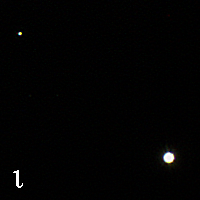 |